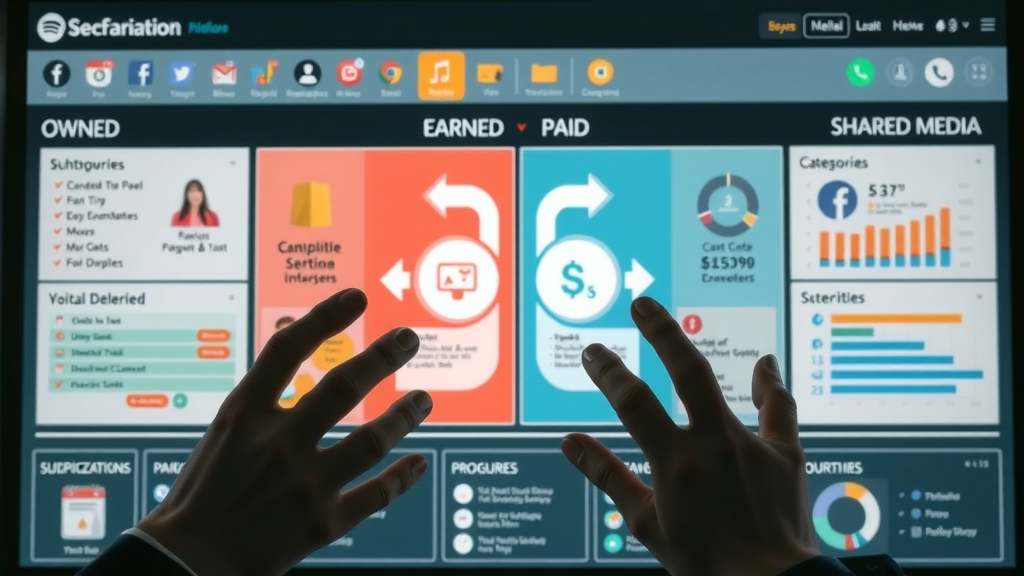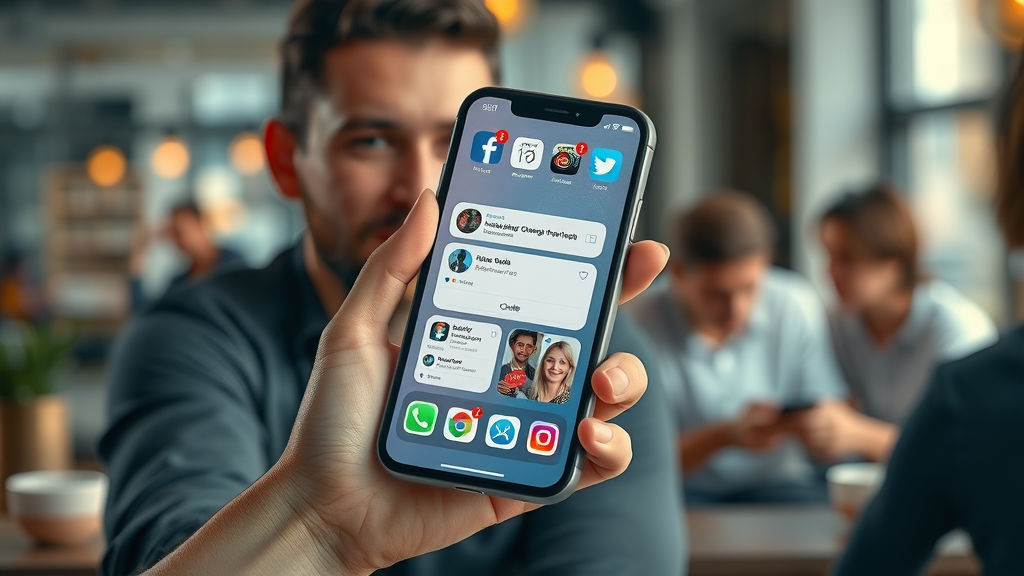Did you know: Brands using multi-channel strategies see engagement rates at least 166% higher than those relying on a single channel? In today's fast-changing marketing world, simply choosing one avenue isn't enough. Media channel marketing enables your brand to reach, engage, and convert your ideal audience—across the places they spend the most time. If you want to skyrocket your brand awareness, foster customer loyalty, and get the most out of your marketing campaigns, mastering media channel marketing is more than an option—it's a necessity. Read on to unlock actionable strategies, process breakdowns, and cutting-edge tips to propel your brand ahead of the competition.

Media Channel Marketing: Harnessing the Power of Multi-Channel Strategies for Maximum Brand Impact
Did you know that brands using multi-channel strategies see engagement rates at least 166% higher than those deploying media channel marketing on a single channel? Discover how integrating various marketing channels can propel your brand forward.
The modern consumer's journey is complex, weaving through social media , email, paid advertising, digital media channels, and more before making a decision. Media channel marketing is about meeting your ideal target audience wherever they are—combining strategies across multiple marketing channels for the biggest impact. By leveraging multi-channel marketing, brands can boost their exposure, build trust, and drive conversions like never before.
Imagine launching a new product: a single Instagram post may attract attention, but pair it with email marketing campaigns, push notifications, and paid ad placements, and your messaging becomes ubiquitous. This orchestrated approach ensures consistency and keeps your brand top-of-mind at every customer touchpoint. The key lies in understanding which media channels best match your goals—and how to weave them together seamlessly for remarkable brand impact.
Elevate Your Brand: Why Media Channel Marketing is Non-Negotiable for Modern Businesses
Defining Media Channel Marketing and Its Growing Importance in Digital Media
Media channel marketing is the strategy of using several media channels —social media, email, paid ads, and more—to broadcast your brand message and engage your audience. As digital media expands, brands must adapt to keep pace with changing consumption habits. With more consumers online, interacting simultaneously across different media platforms , brands that stick to just one avenue risk losing visibility and relevance.
The landscape of digital media means that your brand has a unique opportunity for omnipresent reach. Social media channels, email marketing, and digital media channels each serve a distinct function—boosting engagement and awareness in complementary ways. As user preferences shift, omni-channel marketing becomes necessary for sustainable, measurable growth. Brands that invest in channel marketing now are positioning themselves for ongoing success in a digital-first world.

Key Benefits of Multi-Channel Marketing for Brand Awareness and Customer Engagement
Enhances reach and frequency
Builds brand awareness
Increases customer engagement
Maximizes return on investment
Diversifies touchpoints for your target audience
By utilizing several marketing channels, you increase your visibility and ensure your brand message is reinforced across the platforms your audience trusts most. This approach builds recognition, establishes credibility, and accelerates the decision-making process. Multi-channel marketing lets your brand distance itself from competitors who remain focused on a single platform, all while maximizing the impact and ROI of every marketing dollar spent.
When brands diversify their channel mix, they’re not just increasing brand awareness. They’re actively participating in conversations, fostering meaningful engagements, and nurturing audience loyalty. The result? Higher conversion rates, more referrals, and an audience that feels truly connected to your brand story.
Understanding the Core Components of Media Channel Marketing

Decoding the Media Channel: Types, Functions, and Strategic Roles
"A single media channel is like a solo musician; an orchestrated marketing channel ensemble is a symphony for your audience." — Industry Expert
A successful media channel marketing strategy blends multiple types of channels, each playing a unique role. Owned media refers to platforms you control, such as your website or email list, delivering highly curated messaging to loyal followers. Earned media is coverage you don’t pay for—think organic shares, mentions, or PR articles that boost credibility and reach. Paid media includes everything from paid ad placements on digital networks to sponsored content. Shared media thrives on social platforms, where engagement through sharing and commenting amplifies brand exposure organically.
The true power of channel marketing lies in knowing how and when to combine these diverse channels to achieve your objectives. Owned and earned media foster trust and long-term equity, while paid and shared media provide quick wins and viral opportunities. Recognizing their interplay is essential for orchestrating campaigns that drive measurable results.
Overview of Media Channels: Owned, Earned, Paid, and Shared
To build an effective media channel marketing strategy, it’s vital to understand the specific strengths and roles of each channel type.
Comparing Major Marketing Channels: Reach, Cost, and Effectiveness |
|||
Channel Type |
Reach |
Cost |
Best Used For |
|---|---|---|---|
Social Media |
High |
Low-Moderate |
Engagement, Awareness |
Email Marketing |
Moderate |
Low |
Retention, Conversion |
Paid Ads |
High |
Moderate-High |
Acquisition, Targeted Campaigns |
Content Marketing |
Moderate |
Moderate |
Education, SEO |
Push Notifications |
Niche |
Low |
Re-Engagement, Immediate Action |
Blending these marketing channels allows your brand to maximize visibility, capture prospects at different funnel stages, and create synergy that extends the life and reach of every campaign. By mapping your objectives to the right channels, you increase the chances that your target audience will see, remember, and take action on your brand message.
Building a High-Impact Media Channel Marketing Plan
Identifying the Right Marketing Channels for Your Target Audience
Not every channel is right for every brand. The most successful marketers invest time and resources into knowing where their audience spends time and the types of messages that resonate best. Start by analyzing customer behavior—track which platforms drive the most engagement, which generate conversions, and where conversations about your sector are happening. Try creating detailed audience personas to clarify needs and preferences. Whether it's social media platforms , email marketing, or newer trends like push notifications, letting data lead your decisions is crucial for effective channel marketing.
Once you’ve identified your primary and secondary audiences, test messaging and formats to optimize reach. Monitor the performance across multiple marketing channels , and use insights to refine your channel strategy in real-time. The result is a dynamic, agile approach that maximizes budget while increasing customer loyalty and brand visibility.

Setting Actionable Marketing Objectives across Social Media, Digital Media, and Beyond
Clear, measurable objectives form the backbone of any successful media channel marketing plan. Begin with SMART goals—Specific, Measurable, Achievable, Relevant, and Time-Bound—tailored for each channel. For social media , objectives might center on growing followers or boosting engagement rates. With email marketing , goals may focus on open rates, click-throughs, or conversions. In paid ad campaigns, look to metrics like cost per acquisition and return on ad spend.
Defining objectives channel by channel ensures holistic strategy alignment and helps you quickly spot what’s working and what isn’t. Review your marketing campaigns frequently and adjust tactics as your goals evolve—whether it’s launching a new product, entering a new market, or nurturing existing customers. This rigorous approach keeps all parts of your media channel marketing aligned and accountable.
Crafting Content that Resonates across Multiple Media Platforms
Content is king, but context is queen. Adapting your messaging to fit each platform is crucial. For social media campaigns , use concise, visual storytelling and encourage user-generated content. On email marketing campaigns, prioritize personalization and value-driven calls to action. Blog posts, podcasts, and videos play distinct roles in education and community building on your owned digital media channels.
Cross-promotion is powerful. Repurpose content from one marketing channel for another—transform an insightful tweet into an in-depth blog post, or a webinar highlight into a series of engaging social media clips. The goal: create a cohesive story that feels native in its context and compelling across platforms, driving consistent engagement and reinforcing your brand presence at every turn.

Mapping the Customer Journey to Refine Channel Marketing Delivery
Understanding how customers move from awareness to decision is central to media channel marketing success. Map touchpoints such as social media discovery, email nurture sequences, and conversion-focused landing pages. Identify gaps or drop-off points where you might be losing your target audience, and strengthen messaging and offers accordingly.
Every stage of the customer journey presents new opportunities to connect and build trust. For early-stage prospects, focus on brand awareness through earned media and social channels. As they move closer to a purchase, use personalized email marketing and retargeting paid ads for maximum impact. Refining your marketing strategy around these touchpoints results in more seamless customer experiences and stronger rates of conversion.
Exploring Social Media Channel Tactics in Media Channel Marketing
Best Practices for Social Media Marketing and Audience Segmentation
Social media marketing is about more than just posting regularly—it's about segmenting your audience and delivering tailored content that sparks engagement. Use analytics to break your audience into meaningful groups, such as age, interests, location, and past behaviors. Build personas for each segment, then craft content that speaks directly to each group's needs and preferences.
Leverage paid social ad targeting to further refine messaging. Test creative, timing, and formats across social media channels to discover what resonates most. Finally, maintain a consistent posting schedule tailored for peak engagement windows for each platform—a practice proven to boost reach, loyalty, and social sharing.
Choosing Between Social Media Channels: Platform Strengths and Weaknesses
Key Social Media Channel Comparison |
|||
Platform |
Audience |
Best Content |
Typical ROI |
|---|---|---|---|
Broad |
Videos, Posts |
Moderate |
|
Younger adults |
Visuals, Stories |
High |
|
Professionals |
Articles, Updates |
High B2B |
|
News seekers |
Tweets, Threads |
Real-time Engagement |
Each social media channel serves a different role in your media channel marketing mix. Facebook and Instagram deliver broad reach and high engagement, while LinkedIn is ideal for B2B brand awareness and thought leadership. Twitter/”X” is powerful for real-time news and trending conversations, and emerging platforms like TikTok excel at viral content targeting younger audiences. Assess your brand’s strengths, audience demographics, and resource allocation to prioritize and optimize your channel selection.

Integrating Paid Ad Campaigns within Social Media Platforms
Paid ads on social media platforms enable your brand to break through organic noise and target high-intent audiences with precision. With targeting options for location, interests, behaviors, and demographics, you can create hyper-relevant ads that maximize conversion rates. Combine paid social campaigns with organic activity for an integrated marketing strategy.
Don't overlook retargeting options—serving ads to users who have visited your website or engaged with previous content helps keep your brand top-of-mind. Experiment with ad formats—carousel, stories, video, and lead-gen ads—to see what meets your objectives. Regularly monitor ad performance and A/B test creative to refine your approach and stretch your paid ad budget farther.
Measuring KPIs for Social Media and Media Marketing Success
Effective media channel marketing is data driven. Define KPIs for each channel—such as impressions, click-through rate, engagement rate, follower growth, and customer acquisition. Use built-in analytics tools or third-party platforms to compare channel performance and uncover opportunities for optimization.
Monitor audience sentiment, comment quality, and share-of-voice to add depth to quantifiable metrics. Understanding both leading indicators (such as shares and comments) and lagging results (like final conversions) is essential for continuous improvement in digital marketing efforts.
Expanding Media Channel Marketing Beyond Social: Email, Push Notifications, and Digital Media
Leveraging Email Marketing to Complement Social Media Channel Efforts
Email marketing provides direct access to your audience's inbox—a place where relationships can deepen through highly personalized communication. When paired with social media campaigns, email becomes a bridge, nurturing leads acquired through social channels toward conversion and repeat engagement.
Segment your email list to send tailored messaging, triggered responses based on action, and exclusive content. Measure results (open rates, clicks, conversions) and tweak your content strategy to increase relevance. Use email to share brand stories, promote exclusive offers, and drive traffic to key landing pages, tying all your digital marketing touchpoints together for maximum effect.

Using Push Notifications and Paid Ads to Boost Campaign Reach
Push notifications and paid ads are powerful tools for real-time engagement and campaign amplification. Push notifications allow brands to deliver personalized, time-sensitive messages directly to users’ devices, prompting immediate action or engagement. When layered with targeted paid ad placements, you can extend your campaign’s reach to warm audiences primed to convert.
A strategic approach involves segmenting notifications by behavior, engagement history, or geographic region—ensuring relevance and reducing unsubscribes. For paid ads, retargeting users who have interacted with push notifications increases conversion rates and strengthens brand recall. This synergy between channels is what sets advanced channel marketing strategies apart.
Aligning Public Relations and Content Marketing within Your Media Channel Strategy
Public relations (PR) and content marketing are often overlooked but are critical components of a modern media channel marketing plan. Earned media placements in reputable publications lend credibility and expand reach far beyond what paid efforts alone can achieve. Meanwhile, content marketing supports SEO, drives inbound traffic, and establishes your brand as an industry thought leader.
Integrate PR campaigns with your content calendar; use press releases to amplify product launches, or thought leadership articles to spark conversations on social media channels. Consistency between PR messaging and owned content ensures a unified brand voice across all media marketing efforts. This not only magnifies awareness but also strengthens trust with new and existing audiences.
Unlocking the Power of Digital Media Channel Marketing
What Sets Digital Media Channels Apart from Traditional Media Channels?
The biggest distinction between digital media channels and traditional ones (like print, TV, or radio) is interactivity and measurability. Digital channels allow for two-way engagement, real-time analytics, and rapid optimization. Campaigns can be tracked, measured, and modified based on actual user data, not just broad estimates.
Unlike static billboards or print ads, digital platforms enable you to interact directly with your audience—answering questions, collecting feedback, and customizing offers in moments. This gives digital marketing an incredible advantage for agile brands committed to measurable growth and customer-centric experiences.

Aligning Search Engine Optimization with Digital Media Marketing Channels
To compete on modern digital media channels, businesses must prioritize search engine optimization (SEO) . SEO helps your content marketing assets, landing pages, and website rank higher in search results, driving organic traffic and increasing brand exposure. Combined with strong social signals and earned media, SEO solidifies your brand's authority in key areas of interest for your target audience.
Continually update your website and media marketing assets to align with user intent and trending search terms. Use keyword research tools to find new opportunities, and integrate these findings into email marketing, blog content, and social campaigns for even greater multi-channel impact.
Innovative Digital Media Strategies for Modern Marketing
Innovation is key for successful digital media channel marketing. Explore emerging media platforms such as live streaming, interactive webinars, or AR/VR brand experiences to capture attention in fresh ways. Invest in automation—using tools that personalize outreach, automate follow-ups, and dynamically optimize content based on real-time user actions.
Cutting-edge digital marketing tactics like influencer partnerships, chatbot engagement, and shoppable social posts can fuel explosive brand awareness and engagement. Monitor results, stay agile, and never stop testing—digital media rewards brands that adapt quickly and provide genuine value at every customer touchpoint.
Challenges and Solutions in Multi-Channel Marketing
Overcoming Channel Fragmentation and Message Inconsistency
Managing messaging across multiple platforms can lead to fragmentation, confusing customers and diminishing your brand voice. Overcome this by creating detailed brand guidelines and core messaging pillars that inform every campaign and platform. Assign key team members to review and approve marketing communications, ensuring consistency.
Use content calendars and centralized asset libraries to standardize content across social media, email, and paid ad campaigns. Training your team on unified messaging not only saves time but also fortifies your marketing strategy as your brand scales into new marketing channels.

Synchronizing Data across Marketing Channels
Mismatched data sets can sabotage even the best marketing campaigns. Unify your analytics dashboards to track user journeys across devices and media channels. Use unique tracking links, UTM parameters, or customer IDs to connect data points and understand cross-platform behavior.
Marketing automation platforms can help synchronize data across different marketing channels, ensuring every insight is actionable. By mapping data flows and closely monitoring performance, brands can refine their strategies to create more seamless, successful campaigns.
Tools and Platforms for Effective Channel Marketing and Digital Marketing Integration
Top Digital Marketing Tools for Multi-Channel Management |
||
Tool |
Main Feature |
Best For |
|---|---|---|
HubSpot |
Automation & CRM |
Integrated Campaigns |
Hootsuite |
Social Scheduling |
Social Media Management |
Mailchimp |
Email Campaigns |
Email Marketing |
Google Analytics |
Analytics |
Performance Tracking |
Investing in multi-channel management tools strengthens data accuracy and workflow efficiency. They enable you to plan, execute, and analyze complex marketing strategies in real time—all from one dashboard. This leads to smarter resource allocation, faster pivots, and better results.
Optimizing Media Channel Marketing: Metrics, Analysis, and ROI
Measuring Success: Key Metrics for Each Media Channel
Each marketing channel offers unique metrics to track. For social media : measure reach, engagement, and shares. With email marketing : focus on open, click, and conversion rates. For paid ads : analyze impressions, CTR, and cost per acquisition. Content marketing is measured by page views, time spent, and ranking improvements, while push notifications rely on delivery, open, and click-through rates.
Regular analysis uncovers what’s driving results and where there’s room for improvement. Integrate channel data to understand the full customer journey and make more strategic, data-informed decisions.
Assessing the ROI of Multi-Channel Marketing Strategies
Calculating ROI is essential for prioritizing your resources. Track not only direct conversions, but also indirect value—such as assisted conversions from early-stage channels. Assign value to each touchpoint, using attribution models in your analytics software to reveal which marketing channels are most effective.
Monitor campaign costs, revenue generated, total engagement, and lifetime customer value. This holistic view affirms which channels to scale and which to retire, ensuring your media channel marketing investment drives measurable business growth.
Refining Channel Marketing Efforts through Continuous Improvement
Successful brands embrace ongoing optimization. Use analytics dashboards to monitor trends, test new tactics, and implement feedback loops for rapid learning. This culture of improvement ensures your media marketing campaigns evolve alongside your market, audience, and competition.
Set up regular reviews—monthly or quarterly—where the team analyzes channel performance and pivots as needed. This proactive approach not only boosts ROI but also keeps your brand ahead in the hyper-competitive world of digital marketing.
Watch this animated explainer to discover how advanced analytics dashboards can synthesize data from multiple marketing channels, offering actionable insights to optimize your campaign ROI and strategy.
Case Studies: Brands Winning with Media Channel Marketing
Case Study 1: Leveraging Social Media Channels for Brand Awareness
Consider an emerging fashion brand that strategically combined social media channels —Instagram, Facebook, and TikTok—to launch a viral campaign. By partnering with influencers across each platform, they generated authentic content and amplified earned media, resulting in a 40% jump in brand awareness within one month. Robust analytics showed not just higher traffic, but also deeper audience engagement, more mentions, and increased email list signups.
Their approach: tailor content for each social channel, cross-promote user-generated content, and engage audiences with behind-the-scenes peeks via Stories and Reels. This agility created consistent messaging and viral excitement, showing the ROI of media channel marketing when executed with strategy and creativity.

Case Study 2: Integrating Paid Ads, Email Marketing, and Push Notifications
"The combination of powerful media channels and creative marketing channels is the ultimate growth engine for our brand." — CMO, Leading Retailer
A retail brand wanted to maximize a seasonal promotion. They ran synchronized paid ads on Google and Facebook, launched an email marketing series, and sent time-sensitive push notifications to app users. The result: an 80% lift in campaign reach, a 22% lift in conversion rate, and significant increases in average basket size.
By tracking engagement and conversion across every channel in real-time, the brand was able to refine their spend mid-campaign—focusing resources on the highest-performing touchpoints and optimizing the offer based on live feedback.
People Also Ask
What is a media channel in marketing?
A media channel in marketing is any platform or medium—such as social media, email, search engines, or traditional outlets—used by brands to communicate their messages to target audiences as part of a broader media channel marketing strategy.
What is an example of a media channel?
Examples of media channels include social media platforms like Facebook and Instagram, email marketing platforms, paid advertising channels like Google Ads, and digital media channels such as YouTube.
What are the 4 marketing channels?
The four major marketing channels are direct selling, selling through intermediaries, dual distribution, and reverse channel strategies—each serving unique roles within comprehensive media channel marketing.
What are the three main types of media channels?
The three main types of media channels are owned media (your website, email list), earned media (PR, organic shares), and paid media (ads, sponsored content), which together drive effective media channel marketing campaigns.
Frequently Asked Questions on Media Channel Marketing
How do I choose between marketing channels for my business?
Start by identifying where your target audience spends most of their time and which platforms align with your brand's goals. Analyze performance data, industry benchmarks, and competitor tactics. Test different marketing channels, measure outcomes, and invest more in those that show the strongest engagement and conversion rates.
How does channel marketing differ from media marketing?
Channel marketing focuses on selecting and managing the avenues or distribution pathways through which your products or messages reach consumers, such as retail stores, e-commerce, or partners. Media marketing, meanwhile, emphasizes the messaging side—choosing the right channels (like social media, email, or paid ads) to broadcast brand content and engage audiences directly.
What is the best way to measure the effectiveness of media channel marketing campaigns?
Set clear objectives for each channel and track key performance indicators such as reach, engagement, click-through rates, and conversions. Use analytics tools to integrate channel data for a holistic view, and implement attribution models to understand which touchpoints most influence sales and brand growth.
Can small businesses succeed with multi-channel marketing strategies?
Absolutely! Small businesses can maximize impact by choosing a few high-performing marketing channels, tailoring content for each, and using cost-effective tools to automate and analyze results. Start small, focus on your strengths, and scale up as you gather insights and see measurable growth.
Unlock Your Brand's Growth: Next Steps in Media Channel Marketing Success
Audit your current marketing channel mix
Test new media channels aligned with your audience
Track and refine campaigns using analytics
Stay updated with digital media innovation

"Media channel marketing isn't a one-off tactic—it's the ongoing, dynamic pulse of brand growth in a digital-first era."
Take action now: Audit, experiment, analyze, and iterate your media channel marketing—these are the keys to sustainable growth and true brand leadership.
To deepen your understanding of media channel marketing, consider exploring the following resources:
“What is Multi-Channel Marketing?” ( marketingevolution.com )
This article provides a comprehensive overview of multi-channel marketing, explaining how integrating various platforms can amplify your campaign’s reach and effectiveness.
“Top Marketing Channels in 2025 — Here’s What Your Team Needs to Master [Data]” ( blog.hubspot.com )
This resource offers insights into the most effective marketing channels for 2025, backed by data, helping you stay ahead in the evolving marketing landscape.
If you’re serious about mastering media channel marketing, these resources will provide you with valuable strategies and data-driven insights to enhance your brand’s reach and engagement.
 Add Row
Add Row  Add
Add 




Write A Comment